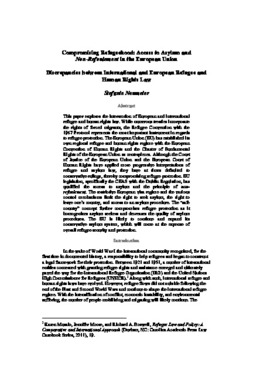| dc.creator | Neumeier, Stefanie | |
| dc.date.accessioned | 2018-02-14T22:22:17Z | |
| dc.date.accessioned | 2021-04-14T14:32:43Z | |
| dc.date.available | 2018-02-14T22:22:17Z | |
| dc.date.available | 2021-04-14T14:32:43Z | |
| dc.date.issued | 2017 | |
| dc.identifier.uri | https://hdl.handle.net/11244.46/1395 | |
| dc.description | © 2017, The Journal of Global Affairs is the official student research publication of the Department of International and Area Studies in the College of International Studies at the University of Oklahoma. Correspondence may be sent to: Journal of Global Affairs, C/O CIS/DIAS, 729 Elm Avenue, Hester Hall 150, Norman, Oklahoma 73019, United States of America. Email: jga@ou.edu. | |
| dc.description.abstract | This paper explores the intersection of European and international refugee and human rights law. While numerous treaties incorporate the rights of forced migrants, the Refugee Convention with the 1967 Protocol represents the most important instrument in regards to refugee protection. The European Union (EU) has established its own regional refugee and human rights regime with the European Convention of Human Rights and the Charter of Fundamental Rights of the European Union as centerpieces. Although the Court of Justice of the European Union and the European Court of Human Rights have applied more progressive interpretations of refugee and asylum law, they have at times defaulted to conservative rulings, thereby compromising refugee protection. EU legislation, specifically the CEAS with the Dublin Regulation, has qualified the access to asylum and the principle of non- refoulement. The restrictive European visa regime and the various control mechanisms limit the right to seek asylum, the right to leave one's country, and access to an asylum procedure. The "safe country" concept further compromises refugee protection as it homogenizes asylum seekers and decreases the quality of asylum procedures. The EU is likely to continue and expand its conservative asylum system, which will come at the expense of overall refugee security and protection. | |
| dc.description.abstract | About Stefanie Neumeier | |
| dc.description.abstract | Stefanie Neumeier received a bachelor's degree in International Studies with a focus on International Relations from the University of Idaho. She is currently enrolled in the International Studies Master's program at the University of Oklahoma. Stefanie's research interests include Theory of International Relations, International Law, Human Rights, Forced Migration/Refugees, and the European Union. She is interested in further exploring regional and international migration and refugee regimes and the development of security institutions and international law. Previously, Stefanie worked as an intern in the US House of Representatives and in the Bundestag in Berlin, as well as volunteering in refugee camps and serving as a mentor to a Bosnian refugee family. After graduation in May, Stefanie will continue her graduate studies as a Ph.D. student in Political Science and International Relations at the University of Southern California. | |
| dc.description.sponsorship | The Journal of Global Affairs is published in conjunction with the College of International Studies at the University of Oklahoma. | |
| dc.format.extent | 13 pages | |
| dc.format.extent | 287,306 bytes | |
| dc.format.medium | application.pdf | |
| dc.language | en | |
| dc.relation.ispartofseries | Journal of Global Affairs ; 6 (January 2017) | |
| dc.relation.requires | Adobe Acrobat Reader | |
| dc.rights | Attribution 4.0 International (CC BY 4.0) | |
| dc.rights.uri | https://creativecommons.org/licenses/by/4.0/ | |
| dc.title | Compromising Refugeehood: Access to Asylum and Non-Refoulement in the European Union | |
| dc.title.alternative | Discrepancies between International and European Refugee and Human Rights Law | |
| dc.type | document | |
| dc.type | text | |
| dc.type | image | |
| dc.contributor.sponsor | University of Oklahoma. College of International Studies | |
| dc.description.undergraduate | undergraduate | |

